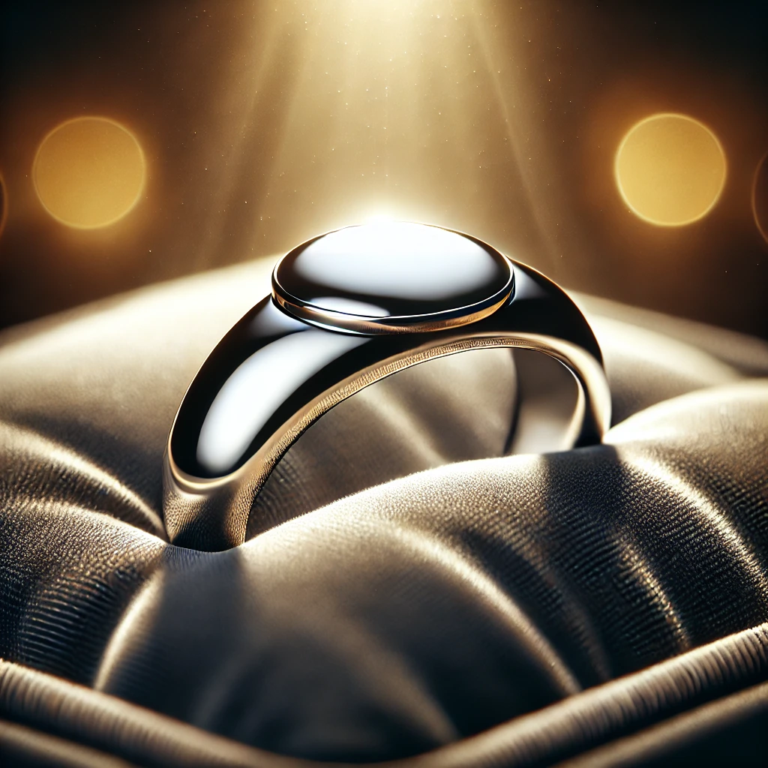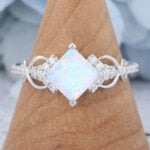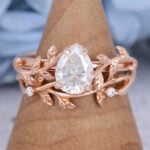Does White Gold Tarnish? How to Restore It?
Before choosing a metal, it is important to understand its properties. White gold is an alloy metal most commonly used in high-end jewelry such as rings, necklaces, earrings, bracelets, etc. Does white gold tarnish? Is white gold worth buying? This article will tell you the answer.
What Is White Gold?
White gold is a silvery-white alloy metal, mainly composed of gold, usually accounting for 58.5% (14K) or 75% (18K), and other metals such as nickel, palladium, and silver to enhance hardness and adjust color. Usually, the surface of white gold is plated with a layer of rhodium to enhance the luster of white gold and prevent it from changing color or oxidation. White gold has a wide range of uses, including jewelry (such as a white gold ring) and crafts.
How is White Gold Made?
Alloying: Mixing gold with metals such as nickel, palladium, and silver to adjust the color and hardness to give it a white hue.
Casting and molding: After melting the alloy, pour it into a mold for casting, and shape the jewelry through processes such as hammering and cutting.
Polishing and finishing: Use polishing tools to polish the surface to make it smooth and shiny, and ensure the accuracy of the inlaid gemstones.
Rhodium plating: A layer of rhodium is plated on the surface of white gold to enhance the luster, prevent white gold from oxidizing, and improve durability.
Final inspection and factory delivery: Perform quality inspection to ensure that the appearance is perfect and then clean the packaging and prepare for delivery to the market.
Does White Gold Tarnish? What does tarnished white gold look like?
The rhodium coating on the surface of white gold can make white gold jewelry appear bright silvery white, which is more shiny than un-rhodium-plated white gold. It can also reduce oxidation, reduce scratches, and improve the durability of white gold jewelry. However, the rhodium layer will gradually wear away with daily wear over time, revealing the white gold inside. White gold will lose its luster and look dull or yellowish after contact with chemicals such as cosmetics and perfumes and daily friction, but it will not oxidize and turn black like silver.
As the rhodium layer wears away, the original yellowish color of the white gold may show through and the jewelry surface may become dull and lack its original bright reflective effect. Long-term wear may cause small scratches on the surface, reducing the gloss and making it look old.

Does White Gold Tarnish - How to Restore White Gold?
- Rhodium Plating: This method is suitable for white gold that has yellowed or lost its luster. Re-plating white gold with rhodium can restore the bright silvery white color of the jewelry.
- Professional Cleaning & Polishing: For white gold jewelry with slight scratches and dirt accumulation that has reduced its luster, you can use ultrasonic cleaning (using high-frequency vibration to remove dirt on the surface of the jewelry) or proper polishing in a jewelry store to remove minor scratches and make the surface of the white gold smoother.
- At-Home Cleaning: For simple cleaning of white gold jewelry at home, you can soak the white gold jewelry in warm water and a small amount of mild soap for 10-15 minutes, then gently clean it with a soft brush, and finally wipe it with a soft cloth.
Does White Gold Tarnish - White Gold Maintenance and Care
Proper white gold jewelry care helps maintain its brilliance and durability over time. To keep your white gold looking its best, clean it regularly with warm water, mild soap, and a soft cloth to remove dirt and oils. Avoid exposure to harsh chemicals, such as chlorine and household cleaners, which can weaken the metal and damage the rhodium plating. Store white gold pieces separately in a soft pouch to prevent scratches. Since the rhodium layer may wear off over time, consider professional polishing and re-plating every 1-2 years to restore its shine.
Does White Gold Tarnish - Conclusion
After reading the article, we have a clear answer to the question ‘does white gold tarnish’. White gold itself does not tarnish, but over time, the rhodium plating that gives it its bright white finish may wear off, revealing the slightly yellowish hue of the underlying alloy. This is a natural process rather than actual tarnishing. To maintain its brilliance, white gold rings that won’t tarnish require regular care, including gentle cleaning and periodic rhodium re-plating every 1-2 years. With proper maintenance, white gold jewelry remains a durable, elegant, and long-lasting choice for fine jewelry.
FAQs About Does White Gold Tarnish
How is white gold made white? Is white gold hypoallergenic? Is there any nickel in white gold?
White gold is made by mixing pure gold with white metals like palladium, silver, or nickel to achieve a lighter color, followed by a rhodium plating to enhance its bright white appearance. Some white gold alloys contain nickel, which may cause allergic reactions, while nickel-free options (like palladium-based white gold) are hypoallergenic and safer for sensitive skin.
Can you wear white gold in the shower? Does white gold fade or scratch easily?
While you can wear white gold in the shower, frequent exposure to soap, shampoo, and chlorine can dull its shine and wear down the rhodium plating over time. White gold itself is durable but can scratch easily, especially when worn daily, so proper care and occasional polishing are recommended.
Is white gold good and real? Does white gold turn yellow? Why does white gold turn yellow?
Yes, white gold like 10k, 14k and 18k white gold are great choices for jewelry due to its durability and elegant appearance. However, it can turn yellow over time as the rhodium plating wears off, revealing the slightly yellowish natural color of the white gold alloy underneath. Regular rhodium re-plating helps maintain its bright white look.
What metals do not tarnish? Does rhodium plating, yellow gold, pure gold, vermeil gold and palladium tarnish or rust?
Some metals that tarnish include silver, copper, and brass, while others remain resistant to discoloration. Pure gold (24K) does not tarnish or rust because it does not react with oxygen or moisture. Rhodium plating helps protect white gold from tarnishing, but it can wear off over time. Yellow gold (mixed with other metals) is highly resistant to tarnish but may lose luster with exposure to chemicals. Vermeil gold (gold-plated silver) can tarnish as the silver underneath reacts with air. Palladium is naturally tarnish-resistant, making it a durable option for fine jewelry.
 Christmas: 25% off All ltems · Code AFJ25 ·Ends Dec 30 30% off All Items ·On Orders Over $600 – Code AMANDA30
Christmas: 25% off All ltems · Code AFJ25 ·Ends Dec 30 30% off All Items ·On Orders Over $600 – Code AMANDA30


